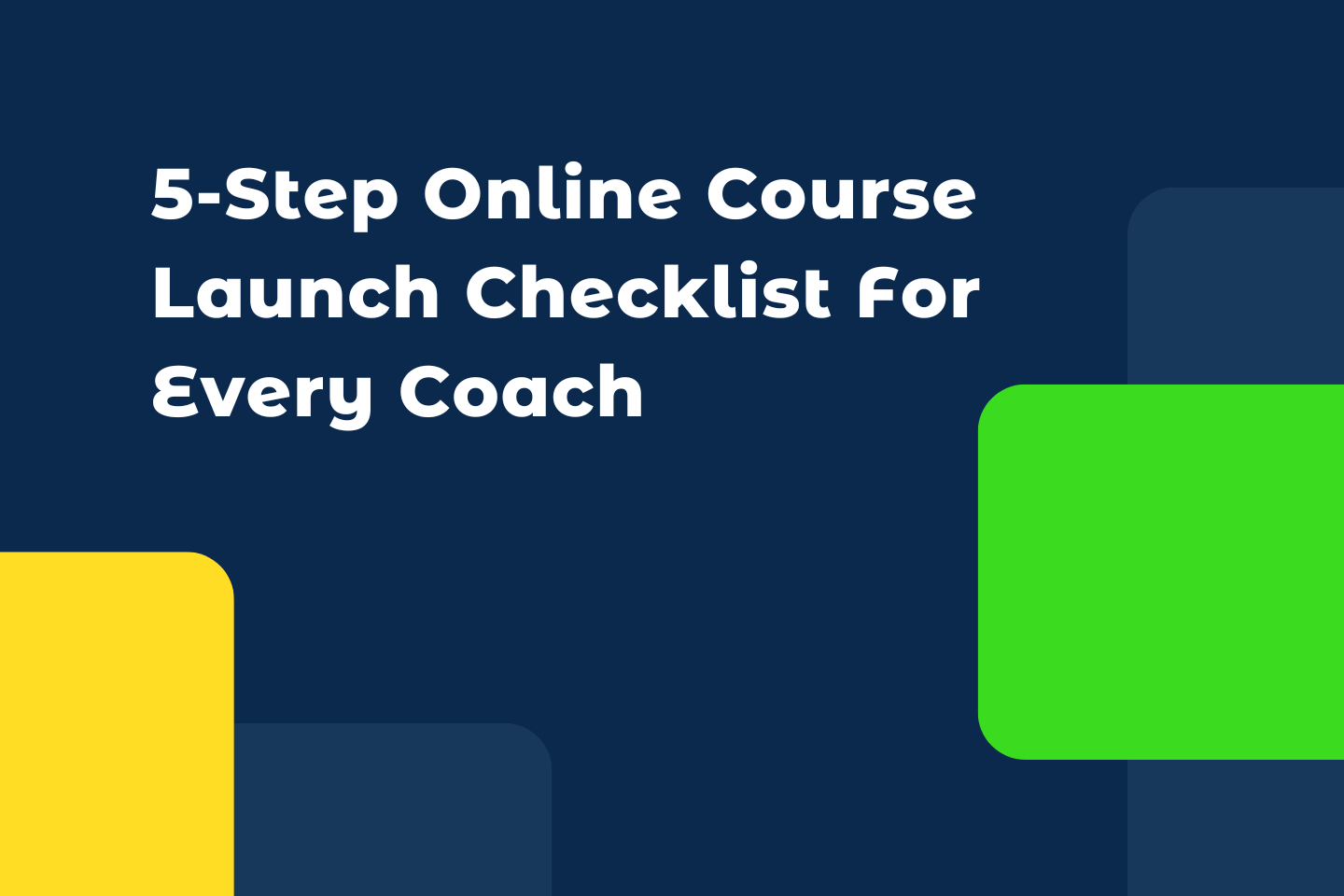Online courses have surged in popularity, providing students and learners with unmatched convenience and opening up lucrative opportunities for coaches. These courses are a great way for students to level up their knowledge without having to commit to a location and time, and for coaches to compete in a thriving market.
So, if you are a coach who wants to find success in the online world, you’ll find a complete online course launch checklist below.
We’ll cover everything from defining objectives and identifying your audience to crafting engaging content and marketing your course—straightforward, no fluff, just the essentials to attract potential students to your courses.
So rather than downloading a million and one online course launch checklists and PDF documents, let us make your life easier by putting everything in one place.
1. Preparing for a Successful Online Course Launch
Preparation is really important before you start developing your online courses.
To start the checklist, you should focus on three fundamental aspects of creating an effective course:
- outlining clear goals and objectives,
- comprehending the needs and characteristics of your target audience, and
- selecting an appropriate topic for your course.
By figuring out where you stand and what your value proposition is, you can chart a meaningful trajectory forward.
Also, recognizing who will be your target audience assures that what you create meets their requirements, which in turn will result in success and profitability.
With that in mind, let’s take a look at how you can tick these three points off your checklist rather quickly.
Setting Clear Goals and Objectives
Imagine beginning a voyage with no specific destination. Chances are, you would wander aimlessly. Similarly, without well-defined goals and objectives for your online course launch, you could find yourself veering off track.
For a coach, those goals can be:
- Student enrollment targets: Set specific enrollment numbers to achieve by certain dates, helping you to focus your marketing efforts and track progress.
- Engagement metrics: Aim for high engagement rates in course activities and materials, enabling you to ensure students are actively participating and absorbing the content.
- Completion rates: Set a goal for the percentage of students who complete the course, which will help you indicate the effectiveness of the course structure and content.
- Feedback and testimonials: Gather a certain number of positive testimonials and constructive feedback to use for course improvement and marketing.
- Upsell opportunities: Develop strategies to introduce students to additional courses or services and with that, increase customer lifetime value.
- Community building: Foster a sense of community among participants, enhancing their learning experience and encouraging peer-to-peer support.
These set objectives (which can vary from coach to coach) not only act as navigational tools during the creation process of your online course, but they also serve as critical standards for the efficacy of your launch strategy. They allow for an evaluation of how effectively marketing strategies are engaging with your intended audience.
Understanding Your Target Audience
Your target audience are individuals on an educational journey with you, and grasping what they hope to gain from the course will help customize the content that best suits their requirements.
But who those people are, is up to you to recognize. Then you can start networking and pinpointing in which direction they need a push in and how your skills can play a part.
This knowledge empowers you to develop course material that directly tackles individual pain points and aspirations, enhancing both the learning experience’s relevance and value.
Choosing the Right Course Topic
When planning your curriculum, make sure that the central theme aligns seamlessly with what you excel in as well as zeroes in on specific competencies or information conducive to student involvement.
As such, when conceptualizing your course idea, make sure it resonates well with both learner aspirations and educational objectives. Once you tick those boxes, it’s time to move forward to the most important part, creating the programs.
2. Picking the Platform That Will Take You to the Top

A good software would help you address the complexities and demands of coaching, so you can go beyond just checking the boxes of your online course launch checklist and realize your full potential.
For example, upcoach is specifically designed to solve the challenges coaches face, allowing you to concentrate more on the transformative aspect of your work and less on the administrative details.
Tailored Features for Every Coaching Style
Likewise, wth upcoach, creating your coaching programs is as straightforward as it gets, thanks to our intuitive program creator. This tool allows you to adapt and structure your sessions to fit various coaching requirements, supporting both individual and group settings.
Handling all your client interactions from one centralized location is another cornerstone of our platform. For example, our CRM system not only organizes client data but also tracks their progress and engagement, ensuring you have all the insights needed to deliver impactful coaching.
Enhancing Client Engagement
The upcoach platform is rich with interactive tools designed to keep your clients fully engaged and invested in their learning journey. From dynamic worksheets and quizzes to vibrant discussion boards, each feature is crafted to enhance the learning experience and encourage active participation.
Customization for Personal Branding
As a coach, you’d like the coaching platform to reflect on your personality and coaching style. For example, we recognize the importance of personal branding in coaching, which is why our platform offers extensive customization options. You can tailor upcoach to reflect your unique brand and style, making it truly your own.
Supporting Your Growth
Last but not least, your primary concern is always coaching and your clients, not figuring out the nitty gritty of the tech.
For example, at upcoach, support is never more than a click away. We offer a wealth of resources to help you maximize the effectiveness of your coaching practice. Our help center, live demos, and community forums are all designed to provide you with the guidance and connections necessary to thrive in your coaching career, and we definitely recommend considering support options when looking out for the coaching platform.
3. Building a Strong Online Presence

Now we move to a checklist point that can make or break your course competitiveness. Everyone is online, and let’s face it, you will have to find a way to market your course in the digital landscape.
Building a strong online presence will help you bring the value your courses offer closer to your prospects.
Creating the right content, leveraging social media and of course, collaborating with well-established individuals in the industry are must-have activities on your checklist too.
Creating Valuable Content
High-quality content can be the driver behind engaging and attracting potential students. This includes videos that preview your course, contributions from guest writers, and impactful social media posts. Such content serves as a direct communication channel with prospective students, providing them with insights and compelling them to learn more about what you offer.
Implementing a content calendar is critical for organizing pre-launch activities, and ensuring a consistent and strategic release of materials like blog articles, podcasts, and webinars. This systematic approach helps maintain student interest and maximizes the visibility of your course.
Leveraging Social Media Platforms
Utilizing platforms such as Facebook, Instagram, Twitter, LinkedIn, and YouTube is crucial for promoting your course. These platforms are highly trafficked and offer significant opportunities to connect with a vast pool of potential students. Choosing the right platforms based on where your target audience spends most of their time is essential for effective promotion.
Effective use of social media can significantly enhance your course’s visibility and attract more students. It’s important to create strategies that engage and excite potential students about your course, utilizing these platforms to maximize reach and impact.
Collaborating with Industry Influencers
Partnering with well-known industry influencers can significantly boost the credibility and reach of your online course. Influencers act as credible sources who can endorse your course, thereby attracting a larger audience to your offerings.
Involving these influencers in your promotional strategy allows you to tap into new markets and demographics within the industry. As you develop your course, consider how to effectively collaborate with respected figures to enhance your course’s appeal and authenticity.
4. Crafting an Irresistible Sales Page

Creating a course sales page that captures attention and converts browsers into signups is more art than science. Your sales page is the front door to your course—it’s where potential students get their first taste of what you’re offering and decide whether it’s worth their time and money.
Writing a Captivating Headline
Your headline is the hook. It needs to pack a punch and promise what your course can uniquely deliver. Think of it as your first impression—make it bold, make it loud, and make it clear. “Transform Your Career in 30 Days with Our Proven Job Interview Techniques” does more than just grab attention; it speaks directly to the aspirations of your prospective students.
Showcasing Course Benefits
This is where you answer the big question every visitor has: “What’s in it for me?” List out the tangible outcomes they can expect. Be specific. If your course offers skills in Adobe Photoshop, don’t just say “learn Photoshop”—say “Master Photoshop and bring your creative visions to life.” Show them how your course is a direct pathway to the skills and achievements they desire.
Remember, your sales page is not just a list of features—it’s a persuasive argument designed to make the case that your course is the next step they need to take. Write with clarity, inject personality, and always keep the reader’s needs and wants in mind. The goal is to make them feel like they can’t afford to pass up this opportunity.
5. Developing a Strategic Launch Plan
Besides just ticking boxes, your launch plan should be about creating a buzz, building anticipation, and ensuring that when you do hit ‘launch’, the market is ready and eager to dive in. This requires meticulous planning and a flair for engaging potential students right from the start.
Pre-Launch Activities
Before your course goes live, it’s essential to get your audience excited about what’s coming. Think of this phase as the pre-party—it’s where you tease the highlights and start the drumroll. Develop compelling lead magnets that are too good to pass up, such as exclusive content previews or first-access passes.
Your launch funnel should be a well-oiled machine, guiding potential students from initial curiosity to eager anticipation with a series of targeted emails and engaging content.
Attention to detail is crucial. Each component, from your landing pages to your social media posts, should be polished and aligned with your overall message. This is your chance to make a first impression that not only resonates but sticks.
Promotional Strategies for Successful Course Launch
When it’s time to go live, your promotion strategies should make waves. Use a combination of targeted social media ads, dynamic email campaigns, and perhaps even live webinars or events to announce your course’s arrival. Imagine you’re throwing the biggest event of the year—every post, ad, and email should echo the excitement and value that your course promises.
Leverage platforms where your audience hangs out. Are they scrolling through Instagram? Networking on LinkedIn? Searching on Google? Meet them there with messages that pop and proposals that persuade.
The goal is to make your course launch not just noticed but celebrated. Create a sense of occasion around it. Your course isn’t just another class—it’s the beginning of a transformation for your students, and your launch should embody that promise.
As you roll out your promotional carpet, remember: this is more than marketing; it’s about making connections that convert into enrollments.
Feeling Proud of The All-Checked List
Now, as you stand ready to launch, you can feel confident in the knowledge that you have done everything to set your course up for success. You’re not just launching a course; you’re launching a potential transformation for every student who enrolls. The journey to this point has been detailed and deliberate, and the seeds you’ve sown are ready to bear fruit.
Celebrate this milestone, for each tick on your online course launch checklist marks not just a task completed, but a step closer to achieving your vision. You’re not just a course creator; you’re an architect of opportunity.
As you finish your checklist before launching the online course do so with pride and anticipation for the success that awaits both you and your future students.
